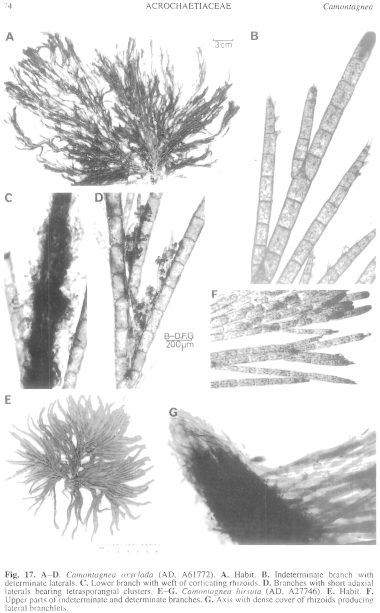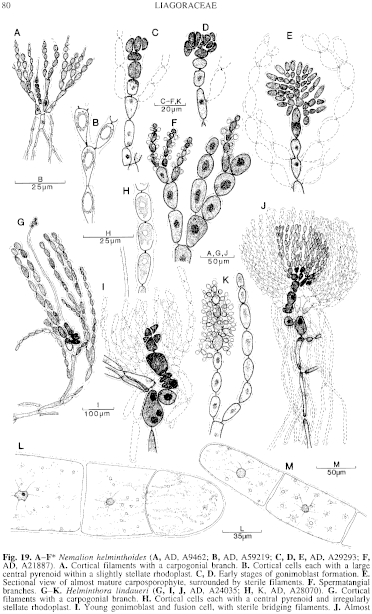|
|
|
|
|
|||||||||||
|
Electronic Flora of South Australia Species Fact Sheet
Phylum Rhodophyta – Class Florideophyceae – Order Acrochaetiales – Family Acrochaetiaceae
Synonyms
Conferva oxyclada Montagne 1839: 5.
Spongomorpha oxyclada (Montagne) Kützing 1854: 17, pl. 79 fig. II. Papenfuss 1964: 8. Taylor 1939: 134. Zaneveld 1969: pl. 82.
Callithamnion scoparium Hooker & Harvey 1845: 273. J. Agardh 1851: 35. Hooker 1847: 490.
Ballia scoparia (Hooker & Harvey) Harvey 1859b: 333; 1860b: pl. 168. J. Agardh 1876: 59. De Toni 1903: 1395. Lucas & Perrin 1947: 351. May 1965: 367. Wollaston 1968: 317, fig. 23A–L.
Thallus (Fig. 17A) medium red, 5–20 cm high, erect and densely tufted, with numerous alternately radial branches at intervals of 2–8 cells, branches uniseriate, linear but tapering slightly basally, indeterminate branches (Fig. 17B) with prominent apical cells 200–400 µm long and 110–120 µm in diameter, lower cells 60–120 µm in diameter and L/D 1.8–3; determinate branches (Fig. 17B) arising subterminally on parent cells, tapering above to an acute apical cell with short one (rarely two)-celled spines borne unilaterally on 3–5 subapical cells, spines becoming curved. Lower branches corticated by a weft of descending (usually) entangled rhizoids (Fig. 17C), 13–26 µm in diameter, cells L/D 2–6 (–8), arising from small cells below the upper end of cells of indeterminate branches. Holdfast fibrous, 2–10 mm across, formed of entangled rhizoids; epilithic. Cells (Fig. 19L) uninucleate with a central suspended nucleus and parietal ribbon shaped rhodoplasts with several pyrenoids in the apical cell and numerous stellate lobed rhodoplasts each with a central pyrenoid in lower cells.
Reproduction: Sexual thalli unknown.
Tetrasporangia (1–4) borne in clusters on cells of short adaxial laterals (Fig. 17D) on lower cells of upper branches, subspherical, 24–32 µm in diameter, irregularly cruciately divided.
Type from Patagonia; holotype in Herb. Montagne, PC.
Selected specimens: Point Avoid, S. Aust., uppermost sublittoral pool (Ricci, 29.xi.1990; AD, A60807). Brown Beach, Yorke Pen., S. Aust., drift (Womersley, 13.iv.1963; AD, A26637). West Bay, Kangaroo I., S. Aust., drift (Womersley, 6.i.1946; AD, A3201). Pennington Bay, Kangaroo I., S. Aust., sublittoral fringe (Womersley, 5.i.1947; AD, A4376). Nora Creina, S. Aust., drift (Wollaston, 14.xi.1955; AD, A20000). 1.3 km off Middle Point, Cape Northumberland, S. Aust., 14 m deep (Shepherd, 13.iii.1975; AD, A46165). Port MacDonnell, S. Aust., drift (Womersley, 24.xi.1992; AD, A61772). Warrnambool, Vic., upper sublittoral (Womersley, 13.iv.1959; AD, A22900). Point Lonsdale, Vic., in reef pools (Sinkora A940, 8.xi.1970; AD, A45963). Walkerville, Vic., drift (Sinkora A1803, 3.xii.1973; AD, A53504). Bastion Point, Mallacoota, Vic., drift (Womersley, I 1.viii.1959; AD, A23125). Gabo I., Vic., 1–3 m deep (Shepherd, 15.ii.1973; AD, A43373). Green Point, Marrawah, Tas., lower eulittoral (Bennett, 29.i.1956; AD, A20630). Ulverstone, Tas., drift (Wollaston, 7.viii.1965; AD, A29619). Cape Surville, Forestier Pen., Tas., 12 m deep (Goldsworthy, 28.ii.1990; AD, A60437). Fluted Cape, Bruny I., Tas., 16 m deep (Shepherd, 10.ii.1972; AD, A41506).
Distribution: Southern South America; New Zealand.
In southern Australia, from Point Avoid, Eyre Pen., S. Aust., to Gabo I., Vic., and around Tasmania.
Taxonomic notes: C. oxyclada is a distinctive species in habit (often with epiphytic Chaetomorpha cohformis) and in branch and cell structure, being common from deep pools to 16 m deep on SE Australian coasts.
References:
AGARDH, J.G. (1851). Species Genera et Ordines Algarum. Vol. 2, Part 1, 1–336 + index. (Gleerup: Lund.)
AGARDH, J.G. (1876). Species Genera et Ordines Algarum. Vol. 3, Part 1 - Epicrisis systematis Floridearum, pp. i-vii, 1–724. (Weigel: Leipzig.)
DE TONI, G.B. (1903). Sylloge Algarum omnium hucusque Cognitarum. Vol. 4. Florideae. Sect. 3, pp. 775–1521 + 1523–1525. (Padua.)
HARVEY, W.H. (1859b). Algae. In Hooker, J.D., The Botany of the Antarctic Voyage. Flora Tasmaniae. Vol. II, pp. 282–320.
HARVEY, W.H. (1860b). Phycologia Australica. Vol. 3, Plates 121–180. (Reeve: London.)
HOOKER, J.D. & HARVEY, W.H. (1845). Algae Novae Zelandiae. Lond. J. Bot. 4, 521–551.
HOOKER, J.D. (1847). The Botany of the Antarctic Voyage. I. Flora Antarctica. Part II, Algae, pp. 454–502, Plates 165–194. (Reeve: London.)
KÜTZING, F.T. (1854). Tabulae Phycologicae. Vol. 4 (Nordhausen.)
LUCAS, A.H.S. & PERRIN, F. (1947). The Seaweeds of South Australia. Part 2. The Red Seaweeds. (Govt Printer: Adelaide.)
MAY, V. (1965). A census and key to the species of Rhodophyceae (red algae) recorded from Australia. Contr. N.S.W. natn. Herb. 3, 349–429.
MONTAGNE, C. (1839). Cryptogames de la Patagonie. In D'Orbigny, A., Voyage dans l'Amérique Méridionale ... pendant ... 1826–1833. Vol. 7. Bot., Part I. Sertum patagonicum, pp. 1–19, Plates 1–4. (Paris.)
PAPENFUSS, G.F. (1964). Catalogue and bibliography of antarctic and subantarctic benthic marine algae. Am. geophys. Un. Antarctic Res. Ser., Vol. 1, pp. 1–76.
PUJALS, C. (1981). Identidad de "Ballia scoparia" (Hook.f. et Harv.)Harv. (Rhodophyta, Florideophycidae). Rev. Mus. Arg. Cienc. Nat. "B. Rivadavia", Bot. 6, 1–22.
TAYLOR, W.R. (1939). Algae collected by the Hassler, Albatross and Schmitt Expeditions. H. Marine Algae from Uruguay, Argentina, the Falkland Islands and the Strait of Magellan. Pap. Michigan Acad. Sc. Arts Lett. 24, 127–164, Plates 1–7.
WOLLASTON, E.M. (1968). Morphology and taxonomy of southern Australian genera of Crouanieae Schmitz (Ceramiaceae, Rhodophyta). Aust. J. Bot. 16, 217–417, Plates 1–10.
ZANEVELD, J.S. (1969). Iconography of Antarctic and Subantarctic benthic marine Algae. I. Chlorophycophyta and Chrysophycophyta. (Cramer.)
The Marine Benthic Flora of Southern Australia Part IIIA complete list of references.
Publication:
Womersley, H.B.S. (14 January, 1994)
The Marine Benthic Flora of Southern Australia
Rhodophyta. Part IIIA, Bangiophyceae and Florideophyceae (to Gigartinales)
Reproduced with permission from The Marine Benthic Flora of Southern Australia Part IIIA 1994, by H.B.S. Womersley. Australian Biological Resources Study, Canberra. Copyright Commonwealth of Australia.
Illustrations in Womersley Part IIIA, 1994: FIGS 17 A–D, 19L.

Figure 17 enlarge
Fig. 17. A, B. Camontagnea oxyclada (AD, A61772). A. Habit. B. Indeterminate branch with determinate laterals. C. Lower branch with weft of corticating rhizoids. D. Branches with short adaxial laterals bearing tetrasporangial clusters. E–G. Camontagnea hirsuta (AD, A27746). E. Habit. F. Upper parts of indeterminate and determinate branches. G. Axis with dense cover of rhizoids producing lateral branchlets.

Figure 19 enlarge
Fig. 19. A–F* Nemalion helminthoides (A, AD, A9462; B, AD, A59219; C, D, E, AD, A29293; F, AD, A21887). A. Cortical filaments with a carpogonial branch. B. Cortical cells each with a large central pyrenoid within a slightly stellate rhodoplast. C, D. Early stages of gonimoblast formation. E. Sectional view of almost mature carposporophyte, surrounded by sterile filaments. F. Spermatangial branches. G–K. Helminthora lindaueri (G, I, J, AD, A24035; H, K, AD, A28070). G. Cortical filaments with a carpogonial branch. H. Cortical cells each with a central pyrenoid and irregularly stellate rhodoplast. I. Young gonimoblast and fusion cell, with sterile bridging filaments. J. Almost mature carposporophyte with sterile involucral filaments and descending rhizoids. K. Spermatangial branch. L. Camontagnea oxyclada (AD, A61772). Apical and subapical cells of an indeterminate branch, with rhodoplasts (with pyrenoids) and a central nucleus. M. Camontagnea hirsuta (AD, A27746). Apical and subapical cells of an indeterminate branch, with rhodoplasts (with pyrenoids) and a central nucleus. [A, C–G, I–K after Womersley 1965.]
* In the following drawings of Liagoraceae, sterile filaments associated with carposporophyte development are shown with broken lines.

|
Email Contact: State Herbarium of South Australia |

|